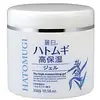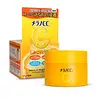What's inside
What's inside
 Key Ingredients
Key Ingredients

No key ingredients
 Benefits
Benefits

 Concerns
Concerns

 Ingredients Side-by-side
Ingredients Side-by-side

Water
Skin ConditioningGlycerin
HumectantButylene Glycol
HumectantDipropylene Glycol
HumectantTriethylhexanoin
MaskingDiphenyl Dimethicone
EmollientPolyglyceryl-10 Myristate
Skin ConditioningPEG-60 Hydrogenated Castor Oil
EmulsifyingCarbomer
Emulsion StabilisingPEG-Crosspolymer
Vigna Radiata Seed Extract
Skin ConditioningIsomerized Safflower Acid
Skin ConditioningSoluble Collagen
HumectantHydrolyzed Collagen
EmollientSuccinic Acid
BufferingDisodium EDTA
Sodium Hydroxide
BufferingCitric Acid
BufferingPhenoxyethanol
PreservativeMethylparaben
PreservativeWater, Glycerin, Butylene Glycol, Dipropylene Glycol, Triethylhexanoin, Diphenyl Dimethicone, Polyglyceryl-10 Myristate, PEG-60 Hydrogenated Castor Oil, Carbomer, PEG-Crosspolymer, Vigna Radiata Seed Extract, Isomerized Safflower Acid, Soluble Collagen, Hydrolyzed Collagen, Succinic Acid, Disodium EDTA, Sodium Hydroxide, Citric Acid, Phenoxyethanol, Methylparaben
Ascorbyl Glucoside
AntioxidantTocopheryl Acetate
AntioxidantDipotassium Glycyrrhizate
HumectantAscorbic Acid
AntioxidantAlpinia Katsumadai Seed Extract
Skin ConditioningCitrus Limon Fruit Extract
MaskingCornus Officinalis Fruit Extract
Skin ConditioningC4-18 Alkyl Methacrylate/Methacryloyloxyethyl Phosphorylcholine Copolymer
HumectantButylene Glycol
HumectantPentylene Glycol
Skin ConditioningGlycerin
HumectantBifida Polysaccharide
HumectantPentaerythrityl Tetraethylhexanoate
EmollientPPG-17 Butyl Ether
Skin ConditioningPotassium Hydroxide
BufferingPolyvinylalcohol Crosspolymer
Diethoxyethyl Succinate
SolventPEG-8 Dimethicone
EmulsifyingPolyglyceryl-2 Hydroxypropyl Ethylhexyl Ether
CleansingPolyacrylamide
Phenoxyethanol
PreservativeGlyceryl Hydroxystearate
EmollientParaffinum Liquidum
EmollientPEG-20 Sorbitan Isostearate
EmulsifyingSodium Paraben
PreservativeBehenyl Alcohol
EmollientCetearyl Alcohol
EmollientPPG-4 Lauryl Ether
EmollientXanthan Gum
EmulsifyingC16-24 Alkyl C16-24 Acidate
Skin ConditioningAcrylates/C5-8 Alkyl Acrylate Copolymer
Emulsion StabilisingParfum
MaskingAscorbyl Glucoside, Tocopheryl Acetate, Dipotassium Glycyrrhizate, Ascorbic Acid, Alpinia Katsumadai Seed Extract, Citrus Limon Fruit Extract, Cornus Officinalis Fruit Extract, C4-18 Alkyl Methacrylate/Methacryloyloxyethyl Phosphorylcholine Copolymer, Butylene Glycol, Pentylene Glycol, Glycerin, Bifida Polysaccharide, Pentaerythrityl Tetraethylhexanoate, PPG-17 Butyl Ether, Potassium Hydroxide, Polyvinylalcohol Crosspolymer, Diethoxyethyl Succinate, PEG-8 Dimethicone, Polyglyceryl-2 Hydroxypropyl Ethylhexyl Ether, Polyacrylamide, Phenoxyethanol, Glyceryl Hydroxystearate, Paraffinum Liquidum, PEG-20 Sorbitan Isostearate, Sodium Paraben, Behenyl Alcohol, Cetearyl Alcohol, PPG-4 Lauryl Ether, Xanthan Gum, C16-24 Alkyl C16-24 Acidate, Acrylates/C5-8 Alkyl Acrylate Copolymer, Parfum
Alternatives
Ingredients Explained
These ingredients are found in both products.
Ingredients higher up in an ingredient list are typically present in a larger amount.
Butylene Glycol (or BG) is used within cosmetic products for a few different reasons:
Overall, Butylene Glycol is a safe and well-rounded ingredient that works well with other ingredients.
Though this ingredient works well with most skin types, some people with sensitive skin may experience a reaction such as allergic rashes, closed comedones, or itchiness.
Learn more about Butylene GlycolGlycerin is already naturally found in your skin. It helps moisturize and protect your skin.
A study from 2016 found glycerin to be more effective as a humectant than AHAs and hyaluronic acid.
As a humectant, it helps the skin stay hydrated by pulling moisture to your skin. The low molecular weight of glycerin allows it to pull moisture into the deeper layers of your skin.
Hydrated skin improves your skin barrier; Your skin barrier helps protect against irritants and bacteria.
Glycerin has also been found to have antimicrobial and antiviral properties. Due to these properties, glycerin is often used in wound and burn treatments.
In cosmetics, glycerin is usually derived from plants such as soybean or palm. However, it can also be sourced from animals, such as tallow or animal fat.
This ingredient is organic, colorless, odorless, and non-toxic.
Glycerin is the name for this ingredient in American English. British English uses Glycerol/Glycerine.
Learn more about GlycerinPhenoxyethanol is a preservative that has germicide, antimicrobial, and aromatic properties. Studies show that phenoxyethanol can prevent microbial growth. By itself, it has a scent that is similar to that of a rose.
It's often used in formulations along with Caprylyl Glycol to preserve the shelf life of products.